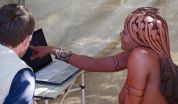(Press-News.org) VIDEO:
NC State researchers have developed a new way to transfer thin semiconductor films, which are only one atom thick, onto arbitrary substrates, paving the way for flexible computing or photonic...
Click here for more information.
Researchers from North Carolina State University have developed a new way to transfer thin semiconductor films, which are only one atom thick, onto arbitrary substrates, paving the way for flexible computing or photonic devices. The technique is much faster than existing methods and can perfectly transfer the atomic scale thin films from one substrate to others, without causing any cracks.
At issue are molybdenum sulfide (MoS2) thin films that are only one atom thick, first developed by Dr. Linyou Cao, an assistant professor of materials science and engineering at NC State. MoS2 is an inexpensive semiconductor material with electronic and optical properties similar to materials already used in the semiconductor industry.
"The ultimate goal is to use these atomic-layer semiconducting thin films to create devices that are extremely flexible, but to do that we need to transfer the thin films from the substrate we used to make it to a flexible substrate," says Cao, who is senior author of a paper on the new transfer technique. "You can't make the thin film on a flexible substrate because flexible substrates can't withstand the high temperatures you need to make the thin film."
Cao's team makes MoS2 films that are an atom thick and up to 5 centimeters in diameter. The researchers needed to find a way to move that thin film without wrinkling or cracking it, which is challenging due to the film's extreme delicacy.
"To put that challenge in perspective, an atom-thick thin film that is 5 centimeters wide is equivalent to a piece of paper that is as wide as a large city," Cao said. "Our goal is to transfer that big, thin paper from one city to another without causing any damage or wrinkles."
Existing techniques for transferring such thin films from a substrate rely on a process called chemical etching, but the chemicals involved in that process can damage or contaminate the film. Cao's team has developed a technique that takes advantage of the MoS2's physical properties to transfer the thin film using only room-temperature water, a tissue and a pair of tweezers.
MoS2 is hydrophobic - it repels water. But the sapphire substrate the thin film is grown on is hydrophilic - it attracts water. Cao's new transfer technique works by applying a drop of water to the thin film and then poking the edge of the film with tweezers or a scalpel so that the water can begin to penetrate between the MoS2 and the sapphire. Once it has begun to penetrate, the water pushes into the gap, floating the thin film on top. The researchers use a tissue to soak up the water and then lift the thin film with tweezers and place it on a flexible substrate. The whole process takes a couple of minutes. Chemical etching takes hours.
"The water breaks the adhesion between the substrate and the thin film - but it's important to remove the water before moving the film," Cao says. "Otherwise, capillary action would case the film to buckle or fold when you pick it up.
"This new transfer technique gets us one step closer to using MoS2 to create flexible computers," Cao adds. "We are currently in the process of developing devices that use this technology."
INFORMATION:
A "just accepted" version of the paper, "Surface Energy-Assisted Perfect Transfer of Centimeter-Scale Monolayer and Fewlayer MoS2 Films onto Arbitrary Substrates," was published online Oct. 27 in ACS Nano. Lead author of the paper is Alper Gurarslan, a Ph.D. student at NC State. Co-authors include NC State Ph.D. students Yifei Yu, Yiling Yu, Francisco Suarez, and Shanshan Yao; Dr. Yong Zhu, an associate professor of materials and aerospace engineering at NC State; Dr. Mehmet Ozturk, a professor of electrical and computer engineering at NC State; and Liqin Su and Dr. Yong Zhang of the University of North Carolina at Charlotte. The research was funded by the U.S. Army Research Office under grant number W911NF-13-1-0201 and the National Science Foundation under grant number DMR-1352028.
COLUMBUS, Ohio - In six out of 10 cases, ovarian cancer is diagnosed when the disease is advanced and five-year survival is only 27 percent. A new study suggests that a cancer-killing virus combined with a chemotherapy drug might safely and effectively treat advanced or recurrent forms of the disease.
Researchers at The Ohio State University Comprehensive Cancer Center - Arthur G. James Cancer Hospital and Richard J. Solove Research Institute (OSUCCC - James), led the cell and animal study. Reporting in the journal Clinical Cancer Research, the researchers showed that ...
Some people experience cold not only as feeling cold, but actually as a painful sensation. This applies even to fairly mild temperatures - anything below 20°C. A group of researchers from Lund University in Sweden have now identified the mechanism in the body that creates this connection between cold and pain. It turns out that it is the same receptor that reacts to the pungent substances in mustard and garlic.
Professor of Pharmacology Peter Zygmunt and Professor of Clinical Pharmacology Edward Högestätt have long conducted research on pain and the connection ...
For several years the Danish health service has been moving towards increased centralisation and specialisation in large hospital departments based on the thesis that this provides better results for patients. A new study involving more than 12,000 Danish patients with hip fractures presents a different picture, however:
"Our study shows that the mortality rate for this group of patients is lower in the smaller hospital departments compared to the larger departments. We can also see that the length of stay in hospital is shorter and the quality of care is generally better, ...
Stanford, CA--Photosynthesis is the process by which plants convert energy from the sunlight into chemical energy in the form of sugars. These sugars are used by plants to grow and function, as well as food for animals and humans that eat them.
Plants grow in environments where the availability of light fluctuates quickly and drastically, for example from the shade of clouds passing overhead or of leaves on overhanging trees blowing in the wind. Plants thus have to rapidly adjust photosynthesis to maximize energy capture while preventing excess energy from causing damage. ...
Researchers from Denmark and the U.S. report that babies of women with rheumatoid arthritis (RA) or pre-clinical RA--the period prior to symptoms--are 1.5 times more likely to be born prematurely in Denmark. Findings published in Arthritis & Rheumatology, a journal of the American College of Rheumatology (ACR), indicate that body measurements of the baby at birth were only slightly lower in children exposed to maternal or preclinical RA compared to those with no exposure to the disease. Paternal RA was not found to impact fetal growth or preterm birth risk.
Roughly one ...
SALT LAKE CITY, Nov. 13, 2014 - A University of Utah study of two African tribes found evidence that men evolved better navigation ability than women because men with better spatial skills - the ability to mentally manipulate objects - can roam farther and have children with more mates.
By testing and interviewing dozens of members of the Twe and Tjimba tribes in northwest Namibia, the anthropologists showed that men who did better on a spatial task not only traveled farther than other men but also had children with more women, according to the study published this week ...
New research indicates that the embryos of women who are overweight or obese at the time they conceive display distinct differences in early development compared to embryos from women of a healthy weight.
The results of the study, published today in the journal Human Reproduction, provide strong evidence for a direct link between what mothers eat and the ability of their fertilised eggs to divide and grow. The researchers claim this could potentially have long-term health implications for any children born from these embryos.
The four key findings of the study, which ...
Just as soldiers on sentry duty constantly adjust their behaviour to match the current threat level, dwarf mongoose sentinels exhibit flexible decision-making in relation to predation risk, new research from the University of Bristol has shown.
Biologists Julie Kern and Dr Andy Radford found that decisions about when to go on duty, what position to adopt and how long to remain on post were all affected by information about the likelihood of danger. Sentinels altered their behaviour depending on both environmental conditions, such as wind speed and social signals, such ...
Human communication has long been associated with an unlikely companion, the homing pigeon; but how these pigeons find their way home is still largely a mystery. 'There is widespread agreement that pigeons are able to determine and maintain flight (compass) directions based on solar and magnetic cues,' says Hans-Peter Lipp from the University of Zurich, Switzerland, and Kwazulu-Natal University, South Africa. However, another piece of the puzzle - how the bird determines its position, known as the map sense - was unclear. Dissatisfied with the current theories - that pigeons ...
SAN FRANCISCO, Nov. 12, 2014 -- Porcelain crabs can adapt to a warming climate but will not have energy for much else beyond basic survival, according to new research published today from San Francisco State University.
The findings have grim long-term implications for intertidal zone crabs as well as the myriad species that depend on them, and could be an indicator of how other intertidal organisms may respond to a rapidly changing climate.
The study is detailed in an article published in the Journal of Experimental Biology and is the first to explore intertidal zone ...

